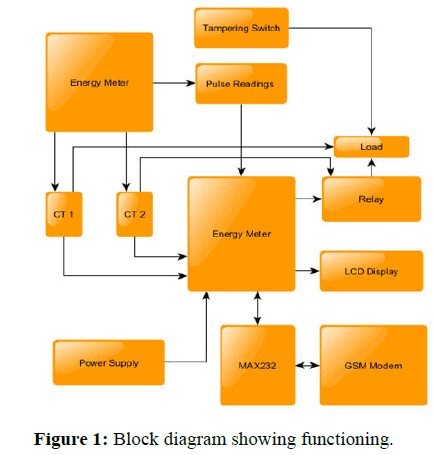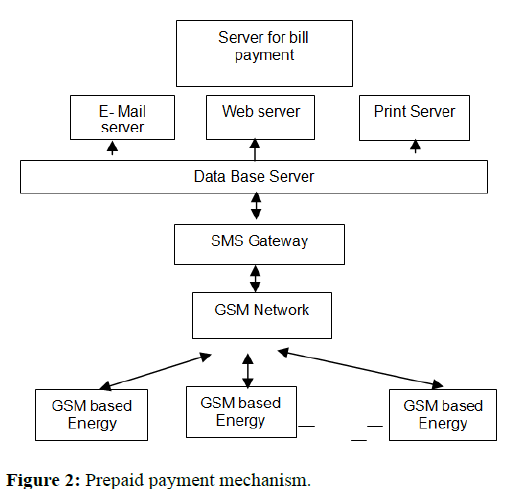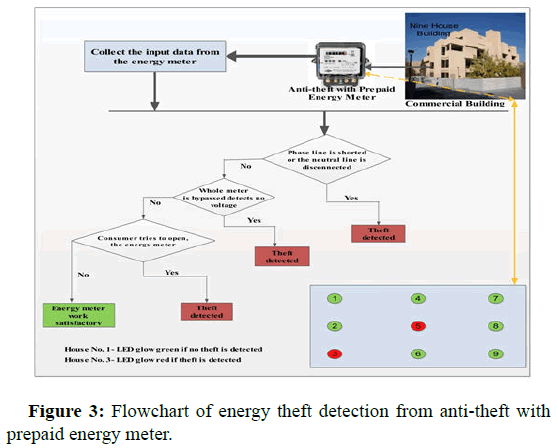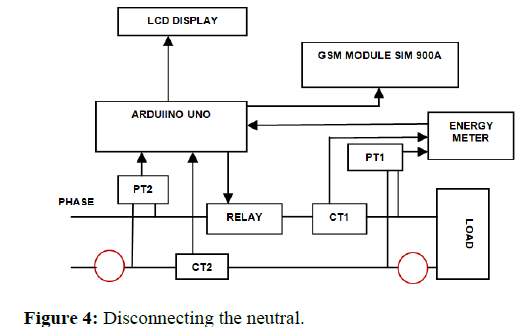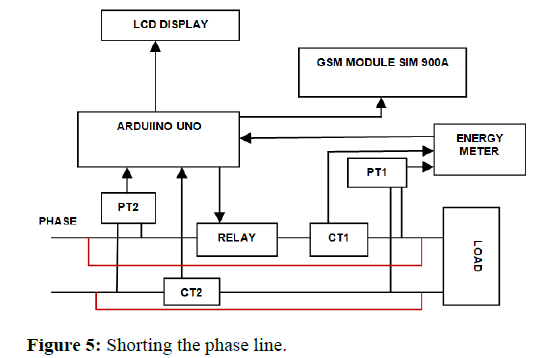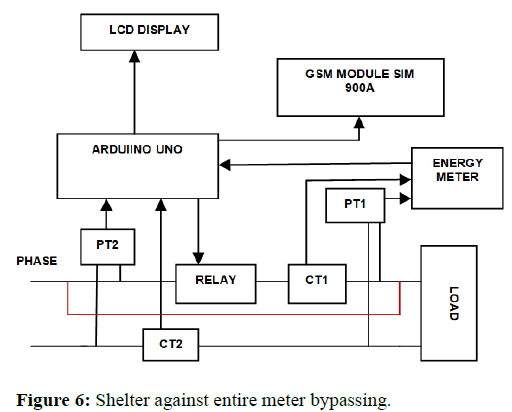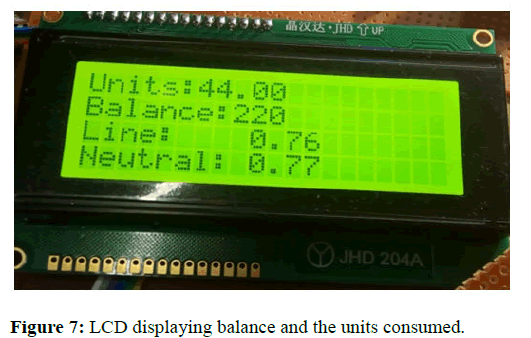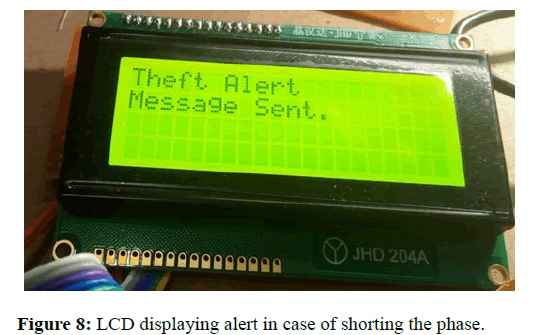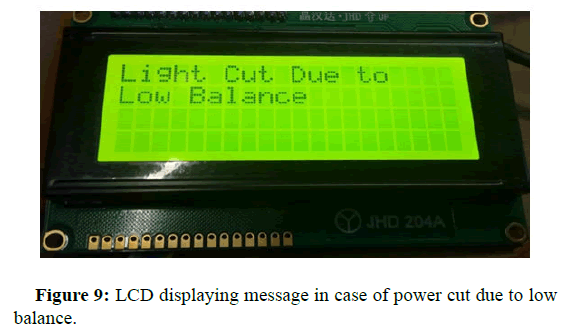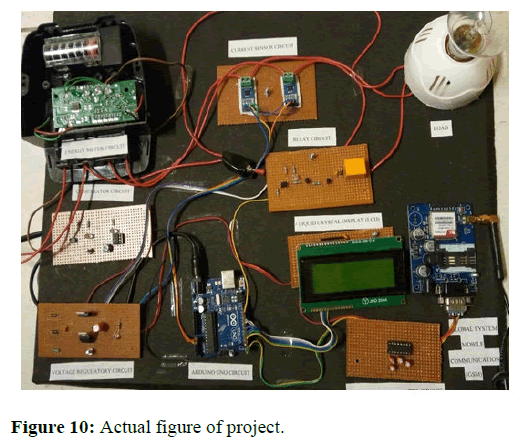Review Article, J Electr Eng Electron Technol Vol: 12 Issue: 4
Design of Single Phase Prepaid Anti-theft Energy Meter
Nitish Arora*
Department of Electrical Engineering, Chitkara University, Punjab, India
- *Corresponding Author:
- Nitish Arora
Department of Electrical Engineering,
Chitkara University,
Punjab,
India;
E-mail: aroranitish362@gmail.com
Received date: 27 January, 2020, Manuscript No. JEEET-23-6740;
Editor assigned date: 30 January, 2020, PreQC No. JEEET-23-6740 (PQ);
Reviewed date: 13 February, 2020, QC No. JEEET-23-6740;
Revised date: 12 July, 2023, Manuscript No. JEEET-23-6740 (R);
Published date: 09 August, 2023, DOI: 10.4172/2325-9838.1000954
Citation: Arora N (2023) Design of Single Phase Prepaid Anti-theft Energy Meter. J Electr Eng Electron Technol 12:4.
Abstract
The proposed project involves designing of energy meter which gives the reading without the person visiting each house. There are three components of meter viz. Global System for Mobile communications (GSM), Code Division Multiple Access (CDMA 2000) and Digital Advanced Mobile Phone Service (D-AMPS). GSM modem contains a SIM card for SMS at the consumer side and SMS gateway at the utility side to send and receive the messages. For communication, CDMA provides access code between partners that are called PN codes. Pilferage of electricity can be substantially reduced as its working is just like a mobile wherein the payment has to be made before utilizing the energy. Data transmission would be charged at standard SMS rates. The transmission of readings at low cost would ensure that power consumption values could be transmitted more regularly at far-flung station. It can be combined with other technologies such as satellite communication which is very sensitive to climate change. When combined with CDMA technology data transmission is improved and interference is mitigated. This particular method can be extended to industrial purpose. For industrial purpose we have to calculate the losses in transmission and distribution network.
Keywords: Energy meter, CDMA, Data transmission, Electricity, Radio Frequency
Introduction
There are three stages in the power management system like generation, transmission and distribution. The better output of the whole system depends on efficient functioning of each stage. To meet the ever increasing demand of electricity, the main attention of utilities is to reduce technical and non technical losses. Several innovative steps like introduction of anti-theft featuresin energy meters has been taken to minimize the incidence of theft of energy or tampering of meters. A Smart Meter (SM) is a device put at the consumer's site which measures real time electricity consumption exactly than a traditional meter [1]. This device has two-way communication technologies that permit the remote and automatic meter readings. This helps to deliver regular bills to the consumers based on the actual consumption without the involvement of humans. It will stop energy felony as it will record energy consumption after regular intervals of time and transfer the same to the consumer on home display or mobile apps. This information to the consumers will help them to stop overuse or wastage. This will also facilitate utilities to integrate the renewable energy production within the electricity grid. This way the utilities can put their demand which will help to introduce versatile tariff schemes or alternative advanced demand response measures. This will stop unsteady electricity production and create balance between demand and supply. Therefore, smart meter will be employed in extremely advanced cases and connected to alternative domains like transport, comfort or security [2].
Smart metering systems could prove to be revolutionary process regime of existing power grids. Transforming the information of smart meters into practical information will enhance the operation as well as the management of distribution networks. The new small grids are generally installed with smart meters in place of normal meter. These meters convey the information to entire different clients via SCADA systems and alternative networks. The working of prepaid energy meter is just like a mobile wherein the payment has to be made before utilizing the energy. The recharging of meter has to be done by the customer before using it. The electrical board has all the control of recharging energy meter and this whole process is completely wireless. All the home appliances will automatically be switched off if the balance in the meter is zero. In order to solve this problem to monitor the balance continuously a small microcontroller is also attached. This small device does all decisions and keeps on reading the status of various sensors and displaying on screen. Furthermore, its speed is very fast which is in micro seconds. In order to step up all the components power supply is attached. A unique feature of the proposed model is that if someone tries to make the theft, it checks and alert the authorities about it automatically. To fulfill this purpose, current sensor is attached in line as well as the neutral wire [2].
Literature Review
Related work
The literature survey has revealed that the technology of electrical meters has undergone a great revolution over the period of time. Although, these meters were in use since the time immemorial but the scientists have put in great efforts to improve their design as well as their applications. The modifications have been done in their models at a very large scale. In previous times, the meters were huge in size and were very heavy due to bulky magnets and coils. But, nowadays the research has been done to reduce their size as well as weight. In addition, it has also led to improve their accuracy. With the change from manual to digital has made the electrical parameters to be measured very easy. The digital age has made the use of voltmeters and ammeters redundant and introduced the impressive features which have overpowered the whole market. The available meters are more rugged in structure with great resolution and easy reading. The digital meters are being modified with introduction of many innovations like remote and prepaid recording that increased their acceptability and potency of utility. These renewals in their models and up gradations have not only improved the operation but also increased the revenue. The reading of such meters is read automatically without going close to it. These devices have great inbuilt memory and mother board.
The reading is downloaded by using ports or from a far off place using Radio Frequency (RF) communication media. This is wireless technology that is exactly the same as used in telephone. It is also linked with an antenna. On pressing a single button, preset information is obtained via RF. The whole data like identification number, accumulative energy consumed etc. are obtained with single command. The data collected can be saved on laptop for future use. Employing this available data, the computer calculates the consumption for the present request amount. It has also been reported that the payment before the utility is made in prepaid meters. From time to time the meter is updated with the credit to consumer and starts deducting consumption from available balance. It has been seen that the meter starts making alarm as the credit reaches a minimum price. It has been reported that the meter get switched off when the credit is totally finished. As the payment is made before use, therefore the penalties are reduced and consumers are benefitted. Moreover, one can plan and use electricity judiciously depending upon the credit in account. The perusal of literature exhibited that the information over the power lines is sent through high frequency carriers [3].
With this, there is no effect on AC power. Furthermore, the receiver filters the data sent by sender from farflung areas. It has been estimated that digital transmission has a property of high potency of transmission. The AMI is finished to the central observer after short time. The comparision of cost and total energy consumption values read by all energy meters is done which gives the estimate of total electricity that's being consumed lawlessly is determined [4].
Proposed system framework
The proposed energy meter is capable of communicating with the consumer as well as the utility with the capability to handle matters related to theft and payment. The block diagram for functioning of prepaid anti theft energy meter is shown in Figure 1.
Prepaid payment mechanism: In the proposed prepaid energy meter, the payment has to be done before utilizing the energy e.g. mobiles. It resembles the concept of prepaid mobile SIM. The (IEC 62056-21:2002 standard) describes a method for direct local data exchange. Control of recharging energy meter is in the hands of electricity board and the consumer. The consumer will pay and electricity board will recharge energy meter according to payments. Recharging of energy meter is completely wireless if energy meter has zero balance then all home appliances will go off automatically. A microcontroller attached with energy meter helps in monitoring the balance and also reads the status of various sensors that is displayed on screen. The speed of microcontroller is in micro seconds. LCD is a display device. The data is transferred via GSM and monthly bills are made after manipulation by the software. Each system has specific ID number which will be provided according to SIM card unique service number. The meter reading is stored in database server through SMS gateway. After billing calculation, a bill is issued by energy provider company which can be sent either by email, by web account or by post. Customers can pay the bill using net banking. GSM also sends the information of power cut, power consumption and power theft through SMS. This sim card service number is used to identify and retrieve customers detail for billing and identification purpose. The entire process is shown in Figure 2 [5].
Electricity theft detection and controlling: The detailed algorithm that has to be followed for detection of energy theft and it is illustrated in Figure 3.
Let us consider an example of commercial building consisting of 9 houses. Each of the house is installed with anti-theft prepaid energy meter. For the detection of energy theft the input data is collected from energy meter and checked whether the phase is shorted or the neutral line is disconnected. If the theft is detected, the LED glows red. If the LED gives green signal then it is checked for the voltage across the meter. If it is zero then it will indicate the whole meter bypassing. If yes, the theft has been detected and the LED glows red. Coming on the next level i.e. if in the previous state if no theft is detected, using the logics used in the programming it is made certain whether the consumer has tried to open the energy meter or not. If no the energy meter is working satisfactorily. The detection of energy stealing is done using this algorithm [6].
Protection against short circuiting the phase line and disjoinging the neutral line: In our proposed system, two current sensors (CT) are used separately in the phase and neutral line. The amount of voltages CT1 and CT2 are measured and sent to analog/ digital I/P (input) of the microcontroller (Figure 4).
If the nonaligned line is disjointed as shown in Figure 4 or the phase line is shorted as shown in then the difference between the output voltages of CT1 and CT2 is zero. If note worthy difference is found, it disjoin the load instantaneously using the relay. The energy meter through GSM modem alerts the server through SMS. When SMS is received, the server blocks the energy meter and inform the authority (Figure 5) [7].
As this is one of the easiest ways of theft by the consumers therefore, current sensors helps in detecting theft.
Shield against entire meter bypassing: Bypassing the entire meter will be detected by no energy consumption condition. The output of PT2 is 5V dc which is passing to the analog/digital input port of the Arduino. The Arduino Uno is a microcontroller board based on the ATmega328 (datasheet). It has 14 digital input/output pins (of which 6 can be used as PWM outputs), 6 analog inputs, a 16 MHz ceramic resonator, a USB connection, a power jack, an ICSP header and a reset button. There will be no voltage measure across PT2 during the whole meter bypassed condition. Then an interrupt is sent to the arduino and it is shown in Figure 6 [8].
The information is sent by energy meter to the server which includes the power status of particular area and location of meter. The confirmation of power availability at particular site by the server will disconnect the load and send back the electricity thievery signal to server. The backup from a rechargeable battery is available during this whole process [9].
Shield against tampering: Consumers may try to open and tamper the energy meter to show no energy consumptions. To overcome this, two lever switches, one to 5V DC supply and other to the arduino are connected. These switches remain closed usually and only microcontroller detects 5V at its two input pins. Otherwise, the microcontroller detects 0V at its input pins. Then arduino instantly notifies the server and disjoin the load from the supply.
Technical standards used
For higher accuracy and precision in the proposed system, microcontroller was used rather than the traditional type of electromechanical meters which have rotating parts and can be tampered. Among the microcontrollers ARDUINO UNO ATmega 328P is preferred due to its sufficient EEPROM memory (1 KB) as well as flash memory (32 KB). It has 16 MHz quartz crystal, 14 I/O ports out of which 6 are PWM (Pulse Width Modulated) pins and 6 are analog inputs. Its I/O ports are capable of handling current up to 20 mA (input and output) which significantly reduces the need for extra interface circuits, such as buffers. Interfacing with the energy meter is required for operator from the electrical utility to reset internal registers, alter the meter configuration and change tariffs. The optoelectronic interface is required to connect energy meter directly to any PC or laptop via the RS 232 serial interface port. The power for the interface is derived from the PC so that no external mains unit or battery is necessary. The accompanying software stores the load profile values which can be used for multiple purposes including spreadsheets. All these features are protected by several layers of stringent security checks/passwords and are not available to the consumer [10].
The most important element in our proposed system is communication between the meter and the utility server. We have selected communication by Short Message Service (SMS). It is supported by different standards namely Global System for Mobile communications (GSM), Code Division Multiple Access (CDMA 2000) and Digital Advanced Mobile Phone Service (D-AMPS). The popularity and wide coverage of cellular network has attracted us to consider the use of SMS service. Our proposed system constitutes an energy meter and GSM modem containing a SIM card only for SMS at the consumer side. At the utility side to send and receive messages SMS gateway is provided. For communication CDMA provides access code between partners that are called PN codes. The receiver can only access the code sent to specific user as each user has different code for transmission containing the information sent. This technology can work in time and frequency domains. It can be combined with other technologies such as satellite communication which is very sensitive to climate change. When combined with CDMA technology data transmission is improved and interference is mitigated [11].
Discussion
The hardware was designed according to the literature review section. The results were obtained as expected. The LCD displayed all the information about the units consumed, balance, line and neutral currents. All these parameters are very much essential for obtaining the results. The current sensors measures the line and neutral currents. If the phase is shorted, information of power theft is sent to utility. This part of the model has been successfully realised.
The project was demonstrated by considering that one unit is equivalent to rupees 5. The meter was recharged with a certain amount and when the balance exhausted the message appeared and electricity supplied to the consumer is switched off. For the verification, two bulbs of 100 watt and 15 watt were used. When 15 watt bulb is being used, the time taken for the complete exhaustion of the units approximately equivalent to 6-7 times the time taken by 100 watt bulb for complete exhaustion [12].
For the verification of the results, the energy meter was recharged with Rs 220. The current sensors employed measured the line current 0.76A and the neutral current 0.77A. It was observed that the results of the current sensors were found to be accurate when measured with the multi-meter. The value of current was within the specified limits and the energy meter was recharged with the amount. As the current measured by the current sensors were within the permissible limits as set in the logic of the microcontroller hence no theft is detected. This is shown in Figure 7 [13].
To demonstrate the model, the theft was induced by shorting the phase line. The message was lucratively sent to the utility indicating pilfering. The current sensors at this point measured the difference between the line and the neutral currents beyond the specified limits. This is shown in Figure 8 [14].
For the demonstration of the cutting of the light in case of low balance one unit is equal to five rupees consumed. When the balance got exhausted, the message was sent as light cut due to low balance. This indicated the satisfactory operation of the relay circuit and the logics used in the model (Figures 9 and 10) [15].
Conclusion
This proposed prepayment systems has provided an innovative solution to the utilities services. The benefit of this project is that the consumers can schedule their electricity consumption. Moreover, in case of any theft detection, the connection of the consumer would be automatically disconnected using the GSM technology and the running cost of electricity will be reduced. Furthermore, people will not waste the electricity and make judicious use of it. Overall, this technology will give better insights to save energy and manpower.
References
- Pepermans G (2014) Valuing smart meters. Energ Econ 45: 280-294.
- Erlinghagen S, Lichtensteiger B, Markard J (2015) Smart meter communication standards in Europe-a comparison. Ren Sustain Energy Rev 43: 1249-1262.
- Carvalho P (2015) Smart metering deployment in Brazil. Energ Proced 83: 360-369.
- Avila LIM, Armijos J, Pesantez D, Zhang Y (2016) Design and implementation of a smart meter with demand response capabilities. Energ Proced 103: 195-200.
- Smith TB (2004) Electricity theft: A comparative analysis. Els J Energ Pol 32: 2067-2076.
- Depuru SSSR, Wang L, Devabhaktuni V, Gudi N (2010) Measures and setbacks for controlling electricity theft. Proceed North Amer Power Syst 12: 1-8.
- Nabil M, Barua A, Arafat MA (2013) A smart prepaid energy metering system to control electricity theft. Int Conf Power Energ Cont 12: 562-565.
- Dick AJ (1995) Theft of electricity-how UK electricity companies detect and determine. Proceed Euro Convent Secur Detect 15: 90-95.
- Bandim CJ, Alves JER, Pinto AV, Souza FC, Loureiro MRB, et al. Identification of energy theft and tampered meters using a central observer meter: A mathematical approach. IEEE Pes Trans Distri Conf Exp 1: 163-168.
- Depuru SSSR, Wang L, Devabhaktuni V (2010) A conceptual design using harmonics to reduce pilfering of electricity. IEEE Pow Energ Soc Gen Meet 1: 1-7.
- Nizar AH, Dong ZY (2009) Identification and detection of electricity customer behavior irregularities. IEEE Power Syst Confer Exp 11: 1-10.
- Pasdar A, Mirzakuchaki S (2007) A solution to remote detecting of illegal electricity usage based on smart metering. Int Work Soft Comput Appl 12: 163-167.
- Zhang Y, Pi DD, Liu CJ, Li J, Xu F (2022) Psychological impact of the COVID-19 epidemic among healthcare workers in paediatric intensive care units in China. Plos One 17: e0265377.
[Crossref] [Google Scholar] [PubMed]
- Sencan I, Bulut D, Sencan IH, Agalar C (2021) Global health emergencies during the pandemic and their solutions. Turk J Med Sci 51: 3194-3206.
[Crossref] [Google Scholar][PubMed]
- Gilleen J, Santaolalla A, Valdearenas L, Salice C, Fuste M (2021) Impact of the COVID-19 pandemic on the mental health and well-being of UK healthcare workers. J Psych Open 7: e88.
[Crossref] [Google Scholar][PubMed]
 Spanish
Spanish  Chinese
Chinese  Russian
Russian  German
German  French
French  Japanese
Japanese  Portuguese
Portuguese  Hindi
Hindi 